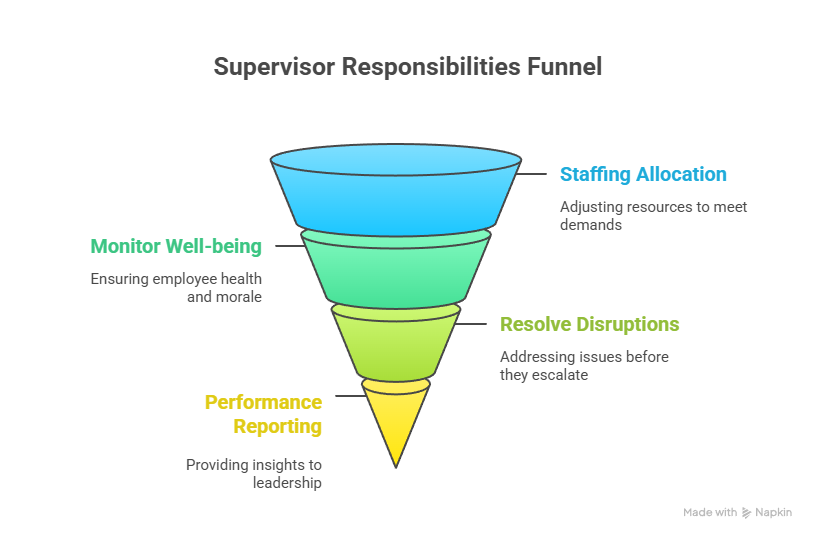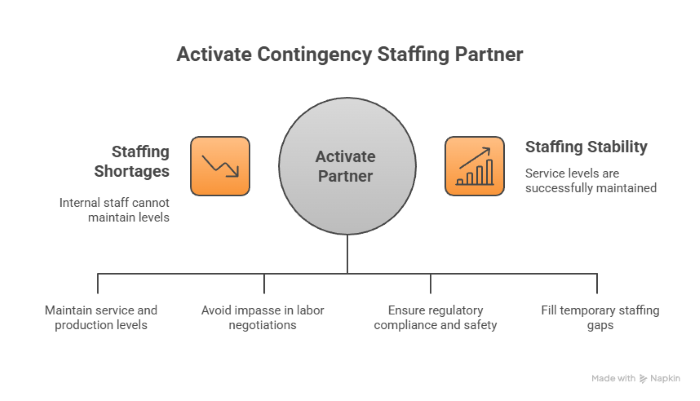
Contingency Staffing as a Continuity Strategy
Labor disruptions create operational instability when critical roles cannot be filled. Contingency staffing provides a structured response framework that allows organizations to maintain production, service delivery, and customer commitments when standard staffing channels are interrupted. Rather than functioning as a temporary patch, contingency staffing is a continuity discipline designed to stabilize operations under pressure.
Organizations adopt contingency staffing to reduce downtime, prevent service interruption, mitigate revenue loss, and maintain workforce safety. The effectiveness of the approach depends on how well labor needs are forecasted, how quickly alternative workers can be identified, and how operational processes shift to support a more fluid workforce environment.
Contingency staffing is not limited to emergency conditions. It also applies to predictable or cyclical shortages, seasonal volume surges, and strategic workforce transitions. The unifying concept is the capacity to maintain operational continuity when primary staffing models cannot meet demand.
Sources of Labor Disruption
Labor disruptions emerge from a range of internal and external factors. The impact varies depending on the industry, the criticality of the affected roles, and the organization’s planning maturity.
Collective Bargaining and Strike Activity
During contract negotiations, work stoppages may occur when labor and management fail to reach agreement. Strikes and lockouts disrupt operations quickly and can last from days to months. Contingency staffing ensures that essential functions continue during these periods without compromising safety or operational integrity.
Sudden Workforce Shortages
Illness surges, unexpected turnover, and shifts in labor availability can reduce staffing capacity. Organizations facing tight labor markets or specialized skill shortages rely on contingency staffing to remain operational while addressing longer-term workforce challenges.
Seasonal and Demand Spikes
Certain industries experience operational surges driven by market cycles, weather patterns, or production schedules. Contingency staffing aligns labor supply to demand without permanent workforce expansion.
Regulatory or Compliance Shifts
New compliance rules, credentialing requirements, or workplace safety mandates can temporarily reduce available labor. Contingency staffing helps bridge gaps while workers obtain required certifications or training.
The Structure of a Contingency Staffing Program
Contingency staffing requires more than access to temporary labor. Effective programs include infrastructure for planning, worker onboarding, deployment coordination, and operational oversight.
Pre-Qualified Talent Pools
The foundation of contingency staffing is a readily available pool of workers who have been screened, verified, and evaluated. Pre-qualification ensures workers can be deployed quickly without sacrificing competence or safety.
Scenario-Based Workforce Planning
Organizations develop staffing plans for different disruption intensities. Each scenario outlines required headcounts, critical job functions, geographic deployment needs, and supervisory support structures.
Credential and Compliance Management
Workers in contingency roles must meet the same credential and compliance standards as permanent employees. Maintaining current records avoids delays during activation.
Logistics and Deployment Coordination
In disruptions requiring travel-based labor reinforcement, deployment teams coordinate transportation, lodging, scheduling, and site orientation. Logistics efficiency determines how quickly replacements arrive and become productive.
On-Site Supervision and Workforce Support
Supervisors and coordinators ensure operational alignment, provide support for contingency workers, and resolve issues that may arise in unfamiliar environments.
Operational Continuity During Strikes and Work Stoppages
Strike-related disruptions require heightened planning and stronger oversight due to elevated operational stress and increased workforce visibility.
Role Prioritization and Function Continuity
Organizations identify critical functions that cannot pause without causing structural harm. These roles receive priority coverage to stabilize production and service continuity.
Transitional Training and Task Simplification
Processes may be temporarily modified to allow qualified contingency workers to execute essential tasks safely and efficiently. Training focuses on core workflows rather than full role scope.
Worker Safety and Conduct Protocols
Strike environments can involve heightened tension or public visibility. Contingency workers must operate within clearly communicated safety zones, reporting structures, and conduct expectations.
Communication Alignment
Clear communication prevents operational confusion. Internal teams, client stakeholders, and contingency workers must share a common understanding of schedules, expectations, and escalation paths.
Maintaining Quality and Productivity During Disruption
Continuity alone is not sufficient. Organizations must maintain quality to preserve customer relationships, regulatory standing, and workplace safety.
Quality during contingency staffing is achieved through structured oversight rather than relying on individual worker experience alone. Supervisors provide direct guidance, monitor performance, adjust staffing allocation, and support problem-solving. Productivity standards may be temporarily adjusted to reflect operational realities, but the goal remains to stabilize output to predictable levels without compromising standards.
Monitoring performance trends allows organizations to anticipate fatigue, skill mismatches, or workload imbalance. This ensures continuity is not achieved at the expense of worker stability or operational safety.
Internal Workforce Considerations
Contingency staffing interacts with existing internal workforce dynamics. Decisions made under disruption influence long-term culture, labor relations, and retention.
Transparent Operational Messaging
Internal employees benefit from clarity regarding why contingency staffing is activated and how long the adjustment is expected to last. Transparency reduces uncertainty and preserves organizational trust.
Reinforcement of Safety Practices
Existing workers and contingency workers must operate under unified safety standards. Consistency reduces risk and supports workforce cohesion.
Reintegration Planning
When disruptions stabilize, organizations require structured reintegration plans to transition back to standard operations without operational slowdown or interpersonal conflict.
Financial and Strategic Value of Contingency Staffing
The financial impact of labor disruption extends beyond wages. Downtime affects production throughput, customer service levels, contractual commitments, and brand reputation. Contingency staffing minimizes exposure to these risks, allowing organizations to maintain momentum even during uncertainty.
Beyond direct continuity, contingency staffing provides strategic advantages:
- Operational Resilience: The organization demonstrates the ability to adapt under pressure.
- Negotiation Stability: During labor negotiations, operational continuity reduces vulnerability.
- Market Reliability: Clients and partners maintain confidence in service consistency.
Contingency staffing supports long-term competitive stability by ensuring that disruption does not define operational capability.
When to Activate a Contingency Staffing Partner
Organizations benefit from forming contingency partnerships before labor disruptions emerge. Early preparation ensures deployment readiness, cost efficiency, and reduced activation friction.
Contingency staffing becomes necessary when:
- Service or production levels cannot be maintained with internal staff
- Labor negotiations trend toward impasse
- Shortages threaten regulatory compliance or safety standards
- Expansion or restructuring creates temporary staffing gaps
The most successful outcomes result when a partner is engaged during planning rather than during crisis escalation.
Selecting a Contingency Staffing Partner
Organizations often engage external partners to secure workforce continuity because contingency staffing requires specialized sourcing, deployment, and supervision infrastructure. Selecting the right partner determines how effectively continuity is maintained.
Strong partners demonstrate:
- Depth of Pre-qualified Labor Pools: Talent pipelines that are already screened, vetted, and credential-ready.
- Rapid Deployment Coordination: Logistics teams capable of managing travel, lodging, scheduling, and arrival sequencing.
- Supervisory and On-Site Workforce Support: The ability to provide field managers who guide workers and maintain operational discipline.
- Scenario-Based Operational Planning: Frameworks for scaling support across small disruptions and full-scale work stoppages.
- Clear Safety and Conduct Standards: Structures that ensure contingency workers operate safely in environments with heightened tension.
Partnership strength is most evident before disruption occurs. Organizations that wait to evaluate partners until a strike or shutdown is underway encounter delays, reduced availability, and elevated cost.
Partnering with a Specialized Contingency Staffing Provider
Organizations facing labor disruptions benefit most when they work with a partner that specializes in rapid-deployment workforce solutions. RSS Inc. provides contingency staffing programs built to stabilize operations during strikes, labor shortages, and high-demand periods. The company maintains a nationwide network of pre-qualified workers who are trained and prepared to deploy under accelerated timelines, ensuring essential functions remain uninterrupted.
RSS Inc. coordinates every stage of deployment, including candidate screening, credential verification, travel arrangements, lodging, shift scheduling, and on-site supervision. This integrated approach reduces the administrative strain placed on internal teams during disruption and accelerates the time it takes to restore operational continuity. Their model is structured to support both short-term reinforcement and extended staffing programs, depending on the duration and scale of the disruption.
During strike conditions, RSS Inc. focuses on maintaining stability, safety, and consistency. Their supervisory teams provide on-site guidance to ensure production standards, conduct expectations, and safety protocols remain clear and consistently followed. This oversight is critical when deploying workers into unfamiliar environments under time-sensitive conditions. The combination of capable workforce supply and disciplined operational leadership allows organizations to continue meeting customer, production, and regulatory requirements without compromising quality.
RSS Inc. works closely with leadership teams to build contingency plans before disruptions occur, identifying critical labor roles, defining escalation triggers, and establishing deployment frameworks that can be activated immediately when needed. This proactive preparation reduces uncertainty, strengthens negotiation leverage, and ensures that continuity decisions are made from a position of readiness rather than urgency.
Contingency staffing succeeds when execution is structured, coordinated, and reliable. RSS Inc. provides the workforce, the operational oversight, and the planning discipline required to maintain continuity during periods of disruption—allowing organizations to protect productivity, maintain customer commitments, and preserve long-term operational stability.
Transitioning to Emergency Operations Mode
When a labor disruption begins, organizations shift into a controlled operational state designed to stabilize output while integrating contingency labor. This mode relies on precise coordination between internal leadership, operational teams, and the staffing partner.
Key elements include:
- Centralized Command: A single coordinated decision structure prevents conflicting directives.
- Scope Alignment: Clear definitions of which functions contingency labor supports and which remain internal.
- Workforce Orientation: Rapid but disciplined onboarding ensures workers understand operational expectations, safety standards, and escalation protocols.
- Shift and Task Structuring: Work is organized into manageable units to ensure consistency across varied skill backgrounds.
- Continuous Communication: Regular updates maintain alignment across teams and locations and prevent drift.
Transitioning to emergency operations is most effective when pre-established playbooks are in place rather than improvised under pressure.
Supervisory Control and Performance Stabilization
Contingency staffing is most effective when it is paired with structured, visible supervisory oversight. On-site supervisors serve as operational anchors who maintain workflow continuity, support worker engagement, and ensure adherence to safety and productivity standards.
Supervisors:
- Reinforce operational expectations in real time
- Adjust staffing allocation as output demands shift
- Monitor fatigue, morale, and workload balance
- Escalate and resolve disruptions before they spread
- Provide daily performance reporting to leadership
This supervisory structure fills the continuity gap created when permanent workers, managers, or union leaders are unavailable or disengaged due to disruption. Performance stabilization relies not only on workforce presence but on sustained operational direction.

Specialized Logistics for Traveling Contingency Labor
In many labor disruptions, local labor supply cannot meet organizational needs. Traveling labor pools enable rapid reinforcement across regions, but travel introduces logistical complexity. Efficient deployment minimizes time between assignment confirmation and productive work.
Effective deployment includes:
- Pre-trip scheduling and documented arrival procedures
- Lodging arranged near work sites to reduce transportation time
- Coordinated shift rotations to prevent fatigue
- Dedicated transportation support when public or personal travel is unreliable
- Direct supervisor contact upon arrival to eliminate uncertainty
The tighter the logistics discipline, the faster the workforce becomes fully operational.
Maintaining Safety and Stability in High-Visibility Environments
Strike conditions can include heightened emotional, political, or public visibility. Contingency staffing must maintain a controlled, safety-first approach to avoid escalation.
Safety protocols focus on:
- Defined access points and movement patterns
- On-site orientation to physical layout and emergency procedures
- Clear conduct standards aligned to professional neutrality
- Immediate incident reporting pathways
- Continuous monitoring to detect stress or environmental risk signals
Well-structured safety communication prevents confusion, missteps, and unnecessary friction.
Reintegration After the Disruption Ends
When normal operations resume, organizations transition away from contingency staffing. Reintegration planning ensures continuity does not suffer during the shift back to standard workforce conditions.
Reintegration includes:
- Hand-off briefings between contingency supervisors and permanent managers
- Gradual reduction of supplemental labor rather than abrupt cutoff
- Return-to-work orientation for permanent staff to align on any operational changes made during disruption
- Evaluation of performance data to identify process improvements uncovered during crisis operations
Reintegration is most successful when executed in a phased and predictable manner.
Strategic Value Beyond Crisis Response
Contingency staffing strengthens more than emergency readiness. It contributes to long-term workforce architecture and operational resilience.
Organizations that maintain contingency capacity benefit from:
- Predictable Continuity: Disruptions no longer threaten core service delivery.
- Negotiation Stability: Labor discussions proceed with reduced operational pressure.
- Operational Scalability: Workforce can expand or contract in alignment with demand.
- Cost Control: Temporary labor prevents over-staffing while avoiding downtime losses.
- Organizational Confidence: Leadership makes decisions from a position of stability rather than reaction.
Contingency staffing shifts the organization into a posture of readiness rather than vulnerability.
Continuity Staffing — FAQ
How do organizations prepare for labor disruptions before they occur?
By identifying critical roles, securing pre-qualified labor pools, defining escalation triggers, and establishing deployment procedures.
What makes contingency staffing different from standard temporary staffing?
Contingency staffing is structured for rapid deployment, operational continuity, and on-site supervision during periods of disruption or heightened operational pressure.
How long can contingency staffing remain in place?
It remains in place as long as operational continuity requires. Programs are designed to support short disruptions or extended work stoppages.
Do contingency workers perform the full scope of normal job duties?
They focus on essential functions required to maintain workflow stability, with process adjustments made to ensure safety and consistency.
How does contingency staffing affect labor relations?
When managed transparently and professionally, it maintains operational continuity without antagonizing workforce culture











